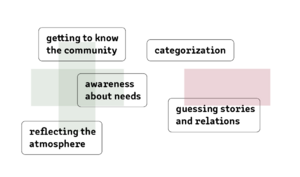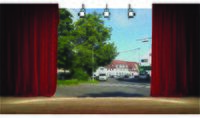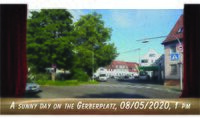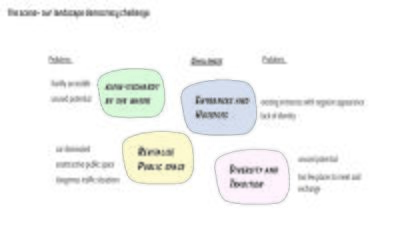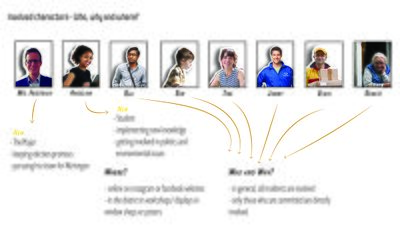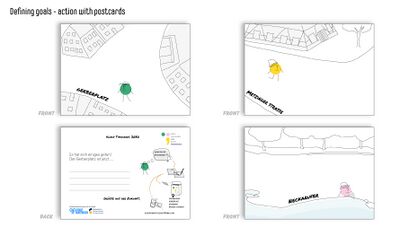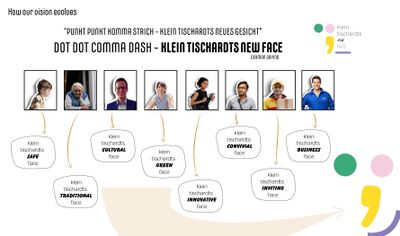LED2LEAP 2020 - Nuertingen Team 3
Jump to navigation
Jump to search
>>>back to working groups overview
| Area | Klein-Tischardt | |
| Place | Nürtingen | |
| Country | Germany | |
| Topics | Strengthening diversity and preserving traditions | |
| Author(s) | Leila Hoffmann, Carolin Lenz, Chiara Marquart, Vanessa Thaser | |
Landscape Democracy Rationale
- Klein-Tischardt is a very mixed district. Different social groups live there in different forms of housing. We see a particularly high need for public open space there. People from different backgrounds and different age groups demand the exchange with other people. For this purpose (open) space must be created. The existing, currently undeveloped building area represents a fragile centre of democracy. In case of doubt, it is here that it can decide whether or not citizens are to be given a say. Moreover, the quarter is crossed by a main traffic axis. This means that more people than just the Klein-Tschardt residents have an interest, whether social or economic, in the design of the quarter.
Location and scope
- map editor
- District Klein-Tischardt, 72622 Nürtingen
Phase A: Mapping your Community
Welcome to your community and its landscape
- district Klein-Tischardt between the rivers Neckar & Steinach
- main road divides KT in two
- buildings with rural character
- unused squares & closeness to the river offers potential
- agricultural background
- high diversity
- high average age
Groups of actors and stakeholders in your community
- more visible groups: senior citizens,citizen’s initiative, families & children, students, refugees, city initiative
- less visible groups: rowers club, small businesses, workers, gastronomy, tourists
Relationships between your actors and groups
- senior citizens play a dominant role in the area
- refugees are less present and dominant
- shared interests: attractive open spaces, meeting points, safe road spaces, space for representation, possibility for interaction, leisure activities
Summary of your learnings from the transnational discussion panel on April 22
- the scale of the projects are completely different
- different approaches to analyse, get to know different methods
- very in-depth informations about the communities through the analysis
- highly appealing graphics, which supported the comprehensibility of the presentation
Theory reflection
- Lynch, Kevin. (1960): The Image of the City, Cambridge, Mass.: MIT Press
- the image of the city - is a way of making the city more readable and working with defined tools that’s a very practical method to work with a city and we think a recognisable district supports the identity and community
- we see it critically to categorize the community so strongly in groups, for our analysis and design the individuals are crucial
- storytelling is a very identity supporting and creating method, we like how intensively you deal with the community but we find it difficult to guess the stories without getting in touch with the community
References
- traffic space - public space from Stefan Bendiks and Aglaée Degros Podcast The sooner now auf Spotify
- Lynch, Kevin. (1960): The Image of the City, Cambridge, Mass.: MIT Press
Phase B: Democratic Landscape Analysis and Assessment
The Scene in your Story of Analysis
- unused public spaces
- diverse community with different backgrounds of the resident groups
- no neighbourhood identity
- unorganized traffic concept
The Actors in your Story of Analysis
- For the following scene the main stakeholders are Vladi the postman and Tina the cyclist.
- The other actors in this scene as granny Renate, Jimmy of Tyers Herl, Mr Smith the police officer, refugee Raj and schoolboy Ben are minor relevant or just people passing by.
- They all stand for the diversity of Kleintischardt's society. This is why those actors are equally important for the results of our analysis.
- Their wishes and needs are of equal relevance for the further design.
The Story of Analysis
- The Gerberplatz has been the central square in Klein-Tischardt since the Middle Ages. Unfortunately not much of this is recognizable anymore and even appreciated. The square is mainly dominated by parking cars, the traffic and the tyre company. In front of this company there is much going on like customers coming, waiting and leaving. But in general you rarely see people using this public space, even though there is this small island of greenery in the left. But it’s surrounded by a dangerous traffic situation.
So let us tell you the story:
- It was sunny and calm friday afternoon on the Gerberplatz.
- Tina on her bike just came from the urban gardening. When a postvan was racing around the corner. This was when the accident happened.
- In the following three scenes you can see how all the people react and interact and how the situation was solved.
Reflect on your Story of Analysis
- We have taken a everyday situation which is based on a true incident and brought it on stage.
- By using storytelling we want to evoke a feeling of empathy in people. Through the story, we have tried to put ourselves in the shoes of different characters and show the problems to the Klein-Tischardter in a way that is close to everydays life.
- Last but not least, we have realized that something has to happen first so that people wake up and see that something has to be changed. Therefore new and better stories can be told.
Phase C: Collaborative Visioning and Goal Setting
The Scene in your Story of Visioning
- Reiterate your landscape democracy challenge, by making a problem statement based on your landscape evaluation and the results of your Phase B assessment. Describe your challenge by digging further into the the physical scene and the community associated with this place.
The Actors in your Story of Visioning
- Describe the particular characters that are going to participate in the visioning phase. Why were they chosen to participate and where will the visioning phase happen?
The Story of Visioning
- Describe the crux of the story. How did the actors engage in collectively developing the goals, and what was the process involved in prioritizing them? Slide 1
- What is the visualization, the actual vision, that expresses the synthesis of these prioritized goals? Slide 2
- What is the strategy that was built for attaining one of these goals, the three year plan of action? Slide 3
Reflect on your Story of Visioning
- What points were most important when formulating goals and what are the common characteristics of a good vision?
- add the corresponding visual from your presentation to the image gallery below
- Yourcase refelction1.jpg
add a caption
Phase D: Collaborative Design, Transformation and Planning
* template coming
Phase E: Collaborative Design, Transformation and Planning
* template coming
= Phase E: Collaborative Evaluation and Future Agendas * template coming
Process Reflection
- Reflect in your intercultural and interdisciplinary team on the outcomes of your study
- Which limitations were you facing?
- What have you learnt from each other?
- What would you do differently next time?
- You can also use diagrams/visuals
- 250 words text






